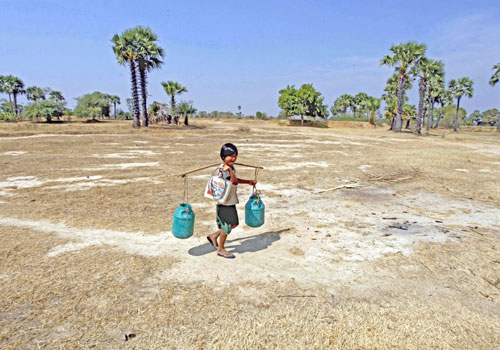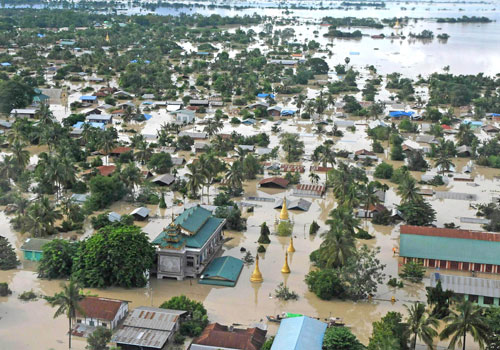
Meanwhile, says Kristensen, the dry season has become longer, with far-reaching implications for communities without access to groundwater. In the highlands people receive only 1000 millimetres (39.3 inches) of rain per year, while in Yangon it is up to 3000mm. As a result, villages face water shortages during the dry season, and local people – especially woman and children – have to walk for hours to search of water, leaving less time for social and economic activities.
For many this marks the beginning of a vicious cycle. Kristensen and his staff have been helping villages to prepare for severe water shortages by providing training on farming practices, soil management and how to better manage resources. In a pilot project with six villages, consisting of about 400 households, communities have also been provided with water tanks, larger water ponds and roofs for rainwater harvesting. The MIID project is just one example of climate adaptation in practice, and it is probable that we are going to see much more of this in Myanmar in the future.
According to the latest projections, Myanmar faces more extreme weather events as temperatures rise: more cyclones, more storms, more floods and more droughts. Before 2000, cyclones made landfall along Myanmar’s coast once every three years. Since the turn of the century, cyclones have made landfall every year. In the Dry Zone – which stretches from lower Sagaing Region to western and central Mandalay Region and most of Magwe Region, encompassing 58 townships – severe droughts have increased in frequency from 1992 to 2002, with the most severe drought taking place in 2010 with extreme temperatures of up to 47.2 degrees Celsius. What is especially alarming is that global warming hits hardest in areas where the population is most concentrated: the Delta Region, which is prone to tropical storms, cyclones and heavy rains, and the Dry Zone, which is most affected by droughts.
These trends are very likely to grow more acute in the future, as new climate modelling presented earlier this year by the WWF shows. Researchers at the Center for Climate System Research at Columbia University, in collaboration with the Department of Hydrology and Meteorology, used state-of-the art climate models to project the Myanmar’s future under different greenhouse gas emissions scenarios. Under the least conservative scenarios, the temperature in Myanmar will increase by between 1.3 and 2.7 degrees by the middle of the century, while precipitation is expected to increase by 2-12 percent in 2011-40 and by 6-27pc by 2041-70.
Hanna Helsingen, green economy program manager for WWF Myanmar, stressed that the predictions still bare uncertainties, as is usually the case with climate simulations. “But this cannot be an excuse for inactivity,” she said. “There is no doubt that we must prepare for more floods, droughts and heat waves.”
The threats posed by climate change have not been lost on the government.
“I don’t know of any other country within the LDCs in which the government takes climate change as seriously as in Myanmar, especially when it comes to adaptation,” said Pasquale Capizzi, chief technical adviser at the Myanmar Climate Change Alliance (MCCA), an initiative funded by the EU, UN-Habitat and UNEP to coordinate climate change initiatives in Myanmar. The MCCA is currently finalising a strategy that will lead the way for climate adaptation. The Myanmar Climate Change Strategy and Action Plan 2016-2030 was prepared in close collaboration with the Ministry of Natural Resources and Environmental Conservation and is due to be released at the end of the year. “It is the one document that should lead climate change adaptation strategies throughout all ministries,” said Capizzi.

Over the past year, the MCCA has worked closely with the government to hold workshops and consultations with 20 ministries, civil society groups, the private sector and communities already affected by climate change.
“A strength of this strategy is its very detailed action plans, which allow stakeholders to implement climate adaptation strategies immediately,” Capizzi said.
MCCA recently collaborated with the WWF on a pilot project to demonstrate how sustainable climate adaptation planning might take place. Pakkoku township in the Central Dry Zone and Labutta township in the Ayeyarwady Delta are both highly vulnerable to climate change. Climate projections for each region were presented to local government departments and communities to involve them in building their own climate resilience.
“We don’t have to persuade farmers of the effects of climate change,” said Helsingen. “They experience themselves that conditions are changing, but often lack a long-term perspective on the causes.”
In Labutta, projections of future sea-level rises have informed an assessment of which areas will suffer from increased freshwater scarcity due to saltwater intrusion and which may be exposed to storm-surges. The projections are used to make sure that infrastructure development or reforestation does not take place in areas that will one day be underwater. The results of the project and climate modelling will be published in December, with detailed information on climate change effects in different regions. Helsingen hopes that the findings will be used by policy makers to plan future development projects.
In theory, climate adaptation measures are ready to be rolled out in Myanmar. But one question remains: Who will pay for all of this? Millions of dollars will need to be spent to ensure that villages along the coast are not washed away by floods and farmers in the Dry Zone don’t suffer from crop failures.
For Capizzi, funding is not the main challenge, though he stresses that more money will be required in the future.
“Myanmar already receives funding from a couple of entities, like the Global Environment Facility, the EU and bilateral development partners,” he said. He is convinced that Myanmar will have access to future funding through the Green Climate Fund, which distributes the annual $100 billion contribution made by advanced economies, agreed at COP21 in Paris.
A more pressing challenge, he says, is building the expertise needed to mitigate the effects of climate change.
“Myanmar needs to build up climate adaptation expertise in a very short time. We need people that can put climate adaption measures into practice over the next 15 years,” he said, a reality not yet reflected in university curriculums.
Meanwhile, Kristensen of the MIID is concerned about the country’s ability to manage the assistance provided by international donors. Coordination is key, he says, if resources are going to help Myanmar prepare for what is to come.
“You cannot overestimate the impacts climate change will have on Myanmar,” he said. “Seventy-five percent of livelihoods depend on agriculture, which is now threatened by water shortages, heat waves, droughts and storms.”
Source: The Myanmar Times | 11 November 2016














